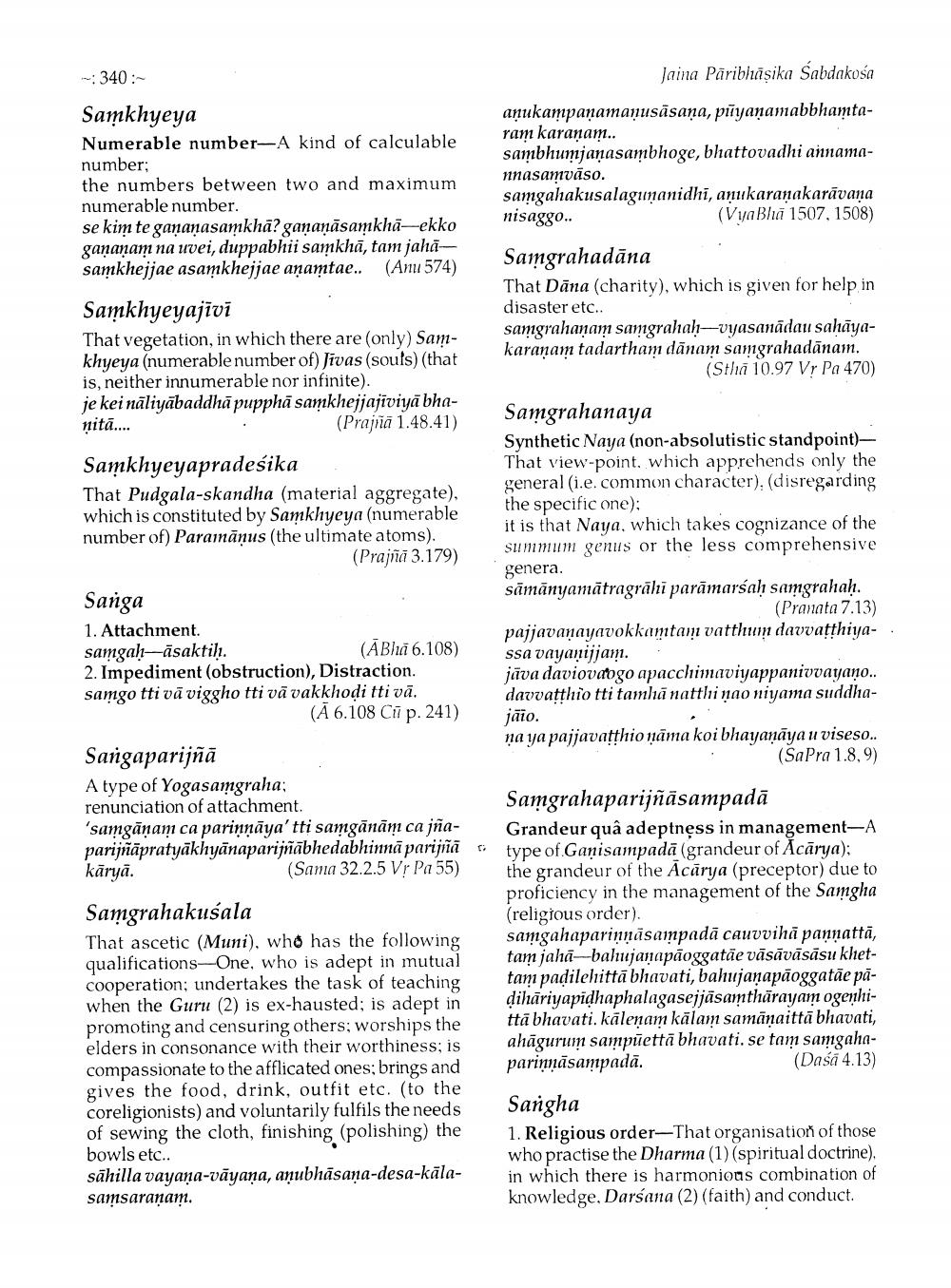________________
340 :
Jaina Pāriblāsika Sabdakosa
aņukampañamaņusāsaņa, puyanamabbhamtaram karanam.. sambhumjanasambhoge, bhattovadhi annamannasamvāso. samgahakusalagunanidhi, anukaranakarāvana nisaggo..
(Vya Bhā 1507,1508)
Samkhyeya Numerable number-A kind of calculable number; the numbers between two and maximum numerable number. se kim te gananasamkhā? gananāsamkhā-ekko gananamna uvei, duppabhii samkhā, tam jahasamkhejjae asamkhejjae anamtae.. (Anu 574) Samkhyeyajivi That vegetation, in which there are (only) Samkhyeya (numerable number of) Jivas (souls) (that is, neither innumerable nor infinite). je kei nõliyābaddhā pupphā samkhejjajiviyā bhanitā....
(Prajna 1.48.41)
Samgrahadāna That Dāna (charity), which is given for help in disaster etc.. samgrahanam samgrahah-vyasanādau sahāyakaraṇam tadartham dānam samgrahadanam.
(Stha 10.97 Vr Pa 470)
Samkhyeyapradesika That Pudgala-skandha (material aggregate), which is constituted by Samkhyeya (numerable number of) Paramāņus (the ultimate atoms).
(Prajĩa 3.179)
Samgrahanaya Synthetic Naya (non-absolutistic standpoint)That view-point, which apprehends only the general (i.e. common character). (disregarding the specific one); it is that Naya, which takes cognizance of the Summum genus or the less comprehensive genera. sāmānyamātragrāli parāmarsah samgrahah.
(Pranata 7.13) pajjavanayavokkamtam vatthum davvatthiyassa vayanijjam. . jāva daviovaogo apacchimaviyappanivvayaņo.. davvatthio tti tamhā natthinao niyama suddhajāio. na ya pajjavatthionāma koi bhayanāya u viseso..
(SaPra 1.8,9)
Sanga 1. Attachment. samgah-āsaktih.
(ĀBhā 6.108) 2. Impediment (obstruction), Distraction. samgo ttivā viggho tti vā vakkhodi tti vā.
(A 6.108 Cu p. 241)
Sangaparijñā A type of Yogasamgraha; renunciation of attachment. 'samgānam ca parinnāya' tti samgānām ca jñaparijäpratyākhyānaparijābhedabhinnā parijā kāryā.
(Sama 32.2.5 Vr Pa 55)
Samgrahakusala That ascetic (Muni), who has the following qualifications-One, who is adept in mutual cooperation; undertakes the task of teaching when the Guru (2) is ex-hausted; is adept in promoting and censuring others; worships the elders in consonance with their worthiness; is compassionate to the afflicated ones; brings and gives the food, drink, outfit etc. (to the coreligionists) and voluntarily fulfils the needs of sewing the cloth, finishing (polishing) the bowls etc.. sāhilla vayana-vāyaṇa, anubhāsana-desa-kālasamsaranam.
Samgrahaparijñāsampadā Grandeur quâ adeptness in management-A type of Ganisampada (grandeur of Acārya); the grandeur of the Acārya (preceptor) due to proficiency in the management of the Samgha (religious order). samgahaparinnāsampada cauvvihā pannattā, tam jahā--bahujanapāoggatãe vāsāvāsāsu khettam padilehittā bhavati, bahujanapāoggatāe pādihāriyapīdhaphalagasejjāsamthārayam ogenhittā bhavati. kālenam kālam samānaitta bhavati, ahāguruin sampūettā bhavati. se tam samgahaparinnāsampada.
(Dasa 4.13)
Sangha 1. Religious order-That organisation of those who practise the Dharma (1) (spiritual doctrine) in which there is harmonious combination of knowledge, Darsana (2) (faith) and conduct.




